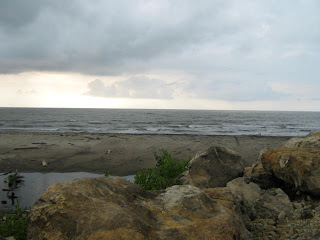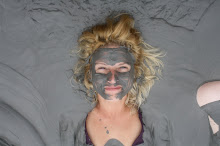Bocas de CenizaIt was a rainy Sunday afternoon in Barranquilla and instead of going for a walk, Yoyi suggested going to
el rio. I knew he meant the Magdalena River, which is a border of Barranquilla. I had crossed it on the bus to Santa Marta, but I hadn’t really been there before.
Barranquilla is not a city for tourists, and because of this there is a lack of information for things for tourists to do here. In the unlikely chance that you ever find yourself as a tourist in Barranquilla,
Bocas de Ceniza is good place to go.
When we got near the river it didn’t seem like we were in Barranquilla anymore, but more like a small town on a river in Colombia. Unlike the overly cementified Barranquilla, the road next to the river and train track was a dirt road, and there was even grass. In the river there were boats and barges.
We got to the
Bocas de Ceniza trencito (the suffix –
ito or –i
ta in Spanish makes things diminutive. This is very common to Spanish language in every Spanish speaking country I’ve been, but here they seem to do it more than anywhere else. Everything gets put in the diminutive for no real reason.)
El trencito really was a
trencito, it wasn’t a really a train, but it did run on a track.
Look at
el trencitoLook at the engine
We waited for the train before to come back. We saw it coming and apparently it needed to be moved from the rusty track. The way this was done was that one guy lifted the front part off the track, then he and another guy pushed it. I thought this was hilarious Colombian engineering, but even Yoyi was laughing.
 |
| "Let's just lift this train off the track and push it over there." |
The train engine was started much the way one starts a gas lawnmower. Then on the completely rusty rickety tracks, the noise from
el trencito moving made it impossible to hear anything else.
 |
| Train vs. taxi |
This looks like the beach at Puerto Colombia, but it’s Barranquilla.
Then we got to what made it really cool, the Rio Magdalena was on one side and the Caribbean Sea was on the other. I have seen this little spit before. From up the hill in my apartment complex, I have often wondered what this little strip of land was and now I was on it.
 |
| Where the river meets the sea: El caribe on the left rio Magdalena on the right |
Meeting up with another train, we just switch cars with the passengers.
When the
el trencito got to what was almost the end of its rusty track, we were able to get out and walk down towards the end of the land.
People who live here are obviously very poor, so they build with whatever they can find. I like the headboard from a bed.
Yesterday in Puerto Colombia we saw millions of crabs due to all the rain, but the ones here were different. These are more like spiders with 8 legs and they move fast. This one was dead so it was easy to get a shot of it.
The track literally had rusted away. It must be hard not to have things rust with a hot salty air from the sea.
 |
| Where the track had rusted away |
The storm was rolling in, but amazingly it didn’t rain the whole time we were on
el trencito or walking.
This is the way people fish here, no pole, just a spool of fishing wire.
You can see where the brown river is meeting the blue sea.
This guy was cooking something that smelled good. I’m pretty sure this was his kitchen.
Although we could see it raining in the distance, it didn’t reach us.
There is just something about the little baby tweet tweet tweet of chicks that is so cute.
What did the world do before these plastic chairs existed? This is the same as my desk chair at school.
Yoyi and I talked about next time renting bikes or a motorbike if we go again.
Here are few more pictures to give you an idea. Yoyi and I were in good company with Jesus,
Sol y Mar, the dog that wanted to get on the train and ride with us, and guys playing dominoes.
 |
| This guy wanted to get on the train with us |
This guy got a flat so our train picked he and his motorcycle up. He sat on his motorcycle while riding the train.
 |
| Yes, the motorcycle on the train |
 |
| Yoyi and me on the train |
Despite the amazingly few times I’ve been on any kind of transportation that has broken down in Colombia, while we were riding along, suddenly our driver jumped off the train while we continued on down the track. I didn’t know what had happened until someone said we had lost our chain. We indeed had. When I rented a bicycle for a month in Playa Sámara in Costa Rica, my rusty chain fell off everyday. I learned the words
cadena oxidado because of this. It was starting to get darker and although they looked close to getting the rusty chain fixed, it didn’t happen. Another
trencito was coming behind us. We didn’t have that much further to go so they decided that the other train would just push us the rest of the way. Yoyi and I were amused at this. It smelled like burning brakes.
 |
| Notice the train behind us pushing us, and the guy on the motorcycle |
 |
| The view of Barranquilla in the distance |
We got off the train and it was getting darker still. Barranquilla's
fútbol team Junior had a big game on but this place looks ready for Junior year round.
 |
| Junior restaurant, notice the parrot, it's real |
 |
| Where we had a dinner of amazing size |
We ended up going into an enormous seafood restaurant on the river. The portion was as proportionally large as the restaurant, we split a
robalo a la plancha and were full. The
aguacero (storm) happened while we were eating, so when we walked out the dirt streets were now muddy rivers. We rode in the second mode of transport that I had never been on in Barranquilla, the bicycle taxi. It was kind of necessary, because otherwise I think I’d have lost a flip-flop in the street that had become a river.
Speaking of this, it sounds just like the aforementioned
arroyo. I didn’t actually see what a real
arroyo, but I did see flooded streets and other parts of Barranquilla that I’d never seen before. It was dark, and even if we had passed an
arroyo, I don’t think a picture would have turned out. Yoyi knows where one is, so next time I’m home during the day and it rains, I’ll find one.
If you are wondering
Bocas de Ceniza, means ash mouth. I can understand the mouth part, like mouth of a river, but the ash part was a mystery to me. Ah, but good old Wikipedia en español solved it. It gets its name from the color of the water from where the ash-grey polluted river water meets the sea.
If you'd like to read more about it, albeit in Spanish:
http://es.wikipedia.org/wiki/Bocas_de_Ceniza





















































